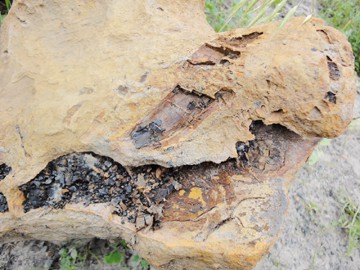Cretaceous Park
Hot enough for you?
The steamy weather we’ve been having might better suit coastal Maryland’s previous residents — considerably previous, some 100 million years ago back in the Cretaceous Era, when dinosaurs such as the predator Acrocanthosaurus, armored Priconodon, herbivorous Tenontosaurus and our official state dinosaur Astrodon johnstoni, a 70-foot-long plant-eater weighing 20 tons, roamed and roared hereabouts.
Maybe they’d feel right at home here this summer, but they’d never recognize their old neighborhood of Dinosaur Alley, a swath going from New England to Georgia and seen locally in the Muirkirk deposit, which runs from north of Baltimore down to D.C. Nor were they immediately recognized when their bones were found on the site of an 18th century iron mine, later a 19th century clay works, which is today a business park in 21st century Laurel.
Now remnants of that unimaginably distant life are being recognized there weekly, since a portion of the Brick Yard development has been set aside as a public dinosaur park. The park is unique in its accessibility for public exploration.
By turning over 41 acres, some seven of which are designated as the public site, to the Maryland-National Capital Park and Planning Commission, property developer Jackson-Shaw has enabled kids of all ages to prowl the slope. There they’re finding chunks of charred-appearing ancient wood called lignite, some detailed enough to show the knots where branches grew; tiny clam shells; tinier pinecone casts; turtle claws and shell fragments; croc teeth and, yes, actual dinosaur ribs, toe bones and teeth.
Jackson-Shaw vice president of development Tom Aylward can’t help noting the irony that dirt bike trails caused the erosion that exposed the fossil site. In addition to the land itself, his company donated the surrounding fencing, developed a Dinosaur Garden of correct-to-Cretaceous-period gingkoes, ferns and evergreens and constructed the parking lot with nods to the area’s historic as well as prehistoric past.
Strictly speaking, it’s not exactly where the critters roamed. What is now a darker layer within the slope was once the bottom of an oxbow lake. Into it the bits and pieces of ancient lifeforms washed, settled out and were covered for all these eons until the 1850s, when miners began to expose them.
Today the fossils are turned up by experts like pith-helmeted Dr. Peter Kranz, the park’s program manager, amateur paleontologist David Hacker, one of the volunteers in T-shirts with slogans like Capitalsaurus, Washington, B.C., and us kids at twice-monthly public sessions or by-appointment-only camp, club and school visits.
  It looks like someone just burned some wood on a stone ledge, but this piece of ironstone actually contained deposits of 100-million-year-old wood called lignite. The impressions of its segments are still visible. |
Digging the Dirt
It’s dirty work, this being a paleontologist, but someone’s got to do it.
“People are really in love with the fact that they can actually participate in discovering the past,” says Donald Creveling, who, as Prince George’s County archaeologist, ought to know.
Of the randomly assorted folks assembled one recent summer Saturday, it was Alex Wojtos, just five and a half and come all the way from Cleveland, Ohio, for his pre-K graduation present, who hit a paleontological payoff by finding one of those little sequoia cones.
So did first-time visitor Chris Hapeman of Columbia. Ryan Clark of Damascus discovered a possible leaf impression. Morris Uhlenbrauck of Germantown, shepherding three-year-old Simon and dinosaur fan Amelia, five, must have wished the kid had seen the fingernail-size freshwater clam before he did.
“Kids are really good at fossil-hunting because they don’t have preconceptions of what things are supposed to look like,” Dr. Matthew Carrano, curator of dinosaurs at the Smithsonian Museum of Natural History, said in a February 2010 article in Smithsonian Magazine.
Still, at least the adults saw better after Kranz, Hacker and other volunteers had us examine the fossils already discovered here.
Our day’s examples might not have been a spectacular haul, but they weren’t bad for a few hours at an unprepossessing barren slope roped off with crime scene tape, whose secrets are only exposed or washed down and out by rain.
Discovery is all by eyeballing and examining; no digging permitted, as it can damage what lies beneath. Anything found must be turned over to the Park and Planning Commission’s partner, the Smithsonian, where a small exhibit at the Museum of Natural History entitled Dinosaurs in Our Backyard displays dinosaur fossils collected mainly by amateurs in the Washington, D.C., area since the 1860s.
That’s where the object discovered last November by a northern Virginia nine-year-old and since identified as a raptor vertebra may eventually reside, along with 20 other specimens from the same site, reports volunteer enthusiast Hacker. That discovery went viral online, bringing Alex Wojtos and his mother from Ohio and other visitors from as far as Chicago and North Carolina to the site Kranz calls “the most important one east of the Mississippi because each time it rains, new fossils wash out.”
A raptor bone found by a child may be sexy, but it’s not necessarily more important than the pinecones and teeth (among them the biggest Priconodon teeth found anywhere in the world), says Kranz.
“Little pieces are important because little critters are likely to be whole,” Hacker agrees.
Stones and Strikeouts
Then there are other things that should be there but haven’t yet been identified, Kranz adds, such as gastroliths, the stones herbivorous dinosaurs ate to aid digestion, just as their avian descendents do today. Trouble is, outside of a stomach they look like, well, stones.
Stones — albeit, we thought, intriguing ones — are what my family found, according to the volunteers standing by to help us identify our finds.
If the park had more volunteers on stand-by, Kranz notes, it could offer additional activities such as screening mud now sitting in pails just waiting to be examined for fossils.
So okay, it’s not another Brownie’s Beach or Calvert Cliffs, where virtually anyone can go home with shark’s teeth, as a disappointed Davidsonville family lamented as they drove away. But those teeth are mere paleo-babies at five to 25 million years of age, nowhere near the 65- to 145-million-year-old Cretaceous deposits. By comparison, those shark teeth are practically … historic.

About the Author: Lane Page spent a quarter-century in community journalism before retiring last year. But she’s back at a keyboard in Howard County, where she lives with her periodontist husband, one son remaining at home, three dogs and a parrot. She visits the Bay regularly on one of the several boats said husband has restored. In fact, it was regularly passing Bay Weekly’s former premises in Deale that ultimately lured Page into these pages.
